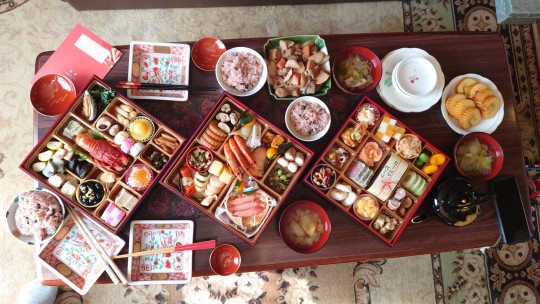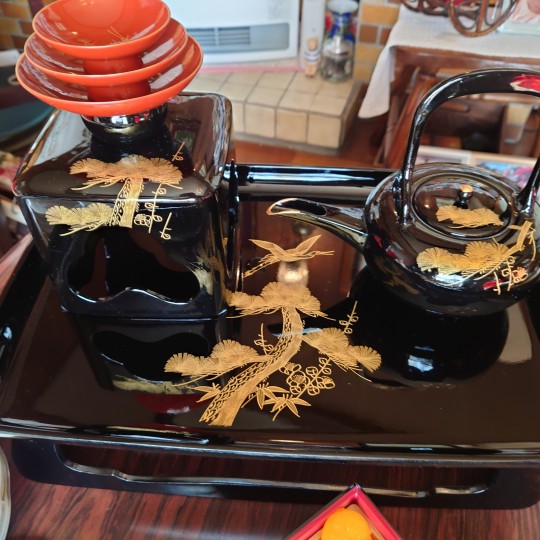#お節料理
Text
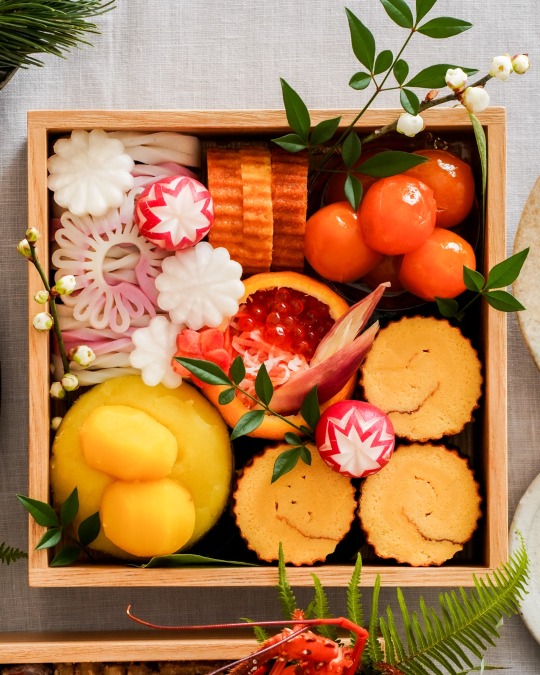


三段お節の盛り付け。
332 notes
·
View notes
Text

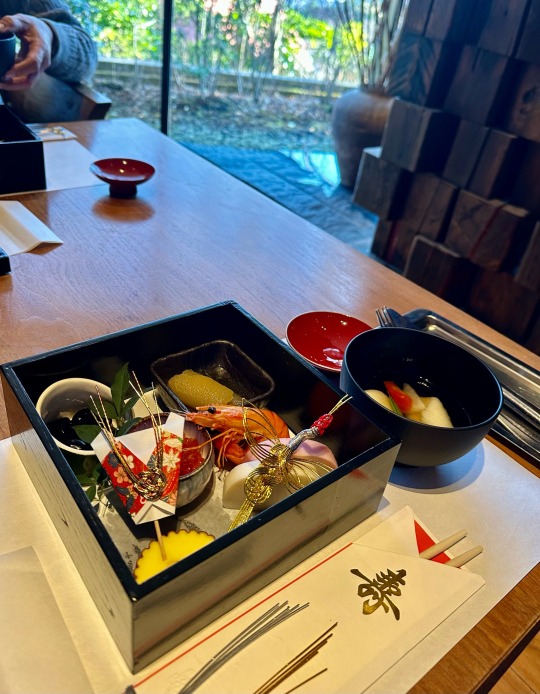
happy new year
Osechi dishes are the traditional meal only prepared for New Year.
235 notes
·
View notes
Text
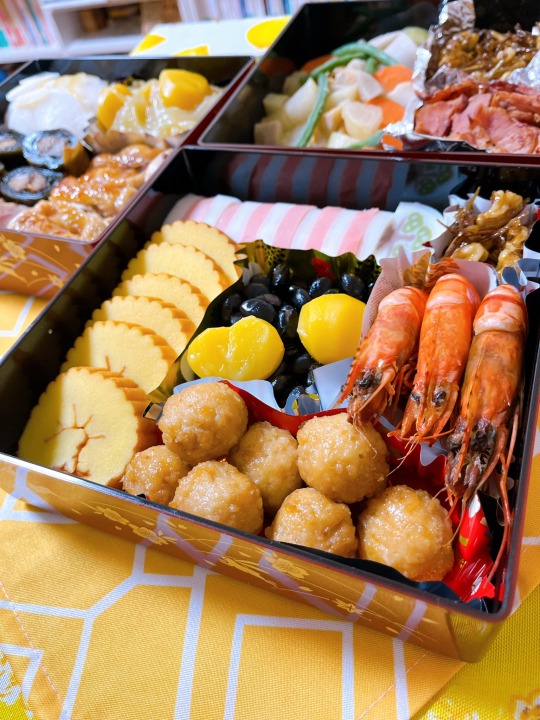
おはようございます
早朝からのお節料理作り、完成しました🍱
作ったり詰めたり
きっときっと美味しく出来たはず❣️
皆様、良いお年をお迎えください
65 notes
·
View notes
Photo

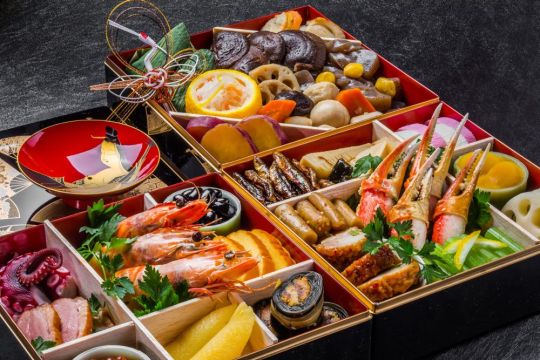
Japanese New Year Tradition: Osechi Ryōri
In Japan, starting off the New Year is more about spending time with family than it is about partying. It's a time of year when people go back to their home towns, pay their first visit to the local shrine, and sit down to some traditional food. And food doesn't get more traditional than osechi ryōri.
The tradition behind osechi ryōri (お節料理) goes back centuries, to the Heian period (794-1185). Ritual offerings of food used to be presented to the gods on sechinichi, or days that marked the changing of the seasons according to traditional Chinese almanacs that were used during this time. The most important sechinichi, of course, was the day that marked the beginning of the New Year. On this day, special dishes were offered to various deities, and also eaten by members of courtly society.
Over the centuries, these traditions made their way to the rest of society, and by the Edo period (1603-1868), they were being practiced commonly around Japan. They combined with other beliefs, notably that on the first days of the New Year, any kind of work — including cooking — was to be avoided. There are two competing theories as to why this was the case. One was that the gods shouldn’t be disturbed by the sounds of cooking on the first days of the year, and the other is simply that the beginning of the year was meant to be a time of rest, when everyone — particularly the women of the household, who did most of the work around the home in those days — could enjoy a well-deserved break.
In the beginning, osechi was quite simple food — vegetables boiled in soy sauce and vinegar — but over the centuries, more and more types of food were added to the osechi ryōri lineup, turning it into a much more elaborate affair. Almost all of these dishes have a special meaning, related either to the name of the food in Japanese or to its appearance or other special characteristics. These are some of the most commonly eaten dishes, and their associated meanings:
Kuromame (黒豆)
Black beans are meant to be a symbol of health, with the associated idea that the person who eats them will be able work hard in the year to come.
Kazunoko (数の子)
This dish is herring roe, but the symbolism is connected both to the large number of tiny eggs, and to the meaning of the Japanese words. Kazu means “number” in Japanese, and “ko” means “children.” The wish behind this item is that the next year will bring many children. For an extra layer of meaning, look to the name of the fish in Japanese: the word for herring is nishin, and if it’s written with an alternate set of kanji (二親), it means “two parents.”
Tazukuri (田作り)
This dish is sardines boiled in soy sauce. Historically, sardines were used to fertilise rice fields, and this word means “rice field maker” in Japanese. Symbolically, this food is eaten in the hopes that the coming year’s harvest will be plentiful.
Kohaku Kamaboko (紅白かまぼこ)
Kamaboko is a kind of fish cake, and kohaku means red and white. The colours represent Japan (most easily found on the country’s flag), and are generally considered to be good luck. According to some, the red colour is meant to prevent evil spirits, while white represents purity. Incidentally, Kohaku Uta Gassen is one of the most popular TV shows that Japanese people watch on New Year’s Eve, and it’s a singing competition between two teams comprising of the most popular singers in Japan — the white (male singers) and the red (female singers).
Datemaki (伊達巻)
This is an omelette mixed with mashed shrimp or hanpen (fish paste). It tastes a little bit different from the tamagoyaki that you might be used to, but it’s rolled into a similar shape, which happens to look like a scroll from the side. That’s why this particular food is associated with learning and scholarship.
Kurikinton (栗きんとん)
These are sweet dumplings that are made from chestnuts. Because they’re yellow in colour, they’re associated with gold, and eating them is meant to bring financial prosperity in the year to come.
Kobu (昆布)
This is a type of seaweed, and this word is closely connected to the word yorokobu, or happiness, which is what this food is meant to bring in the New Year.
Tai (鯛)
Sea bream; the symbolic meaning here is something of a play on words. Tai is part of the Japanese word medetai, meaning happy or joyous. This fish is often eaten on special occasions, and it’s one of the dishes that is served as okuizome, the traditional food that a baby is fed about 100 days after he or she is born. In osechi, it’s meant to bring joy and happiness in the new year.
Shrimp (海老)
The kanji for shrimp mean “old man of the sea,” playing on the sea creature’s bent back and antenna that look like whiskers. This food is meant to bring longevity.
Satoimo (里芋)
Also known as taro root, this dish is eaten in the hopes that the family will be blessed with many children — just like many small taro tubers grow off of the main tuber.
Renkon (蓮根)
Known as lotus root in English, this vegetable has very distinctive holes when it is cut in cross sections. Because you can see clearly when you look through these holes, this food is eaten in the hopes of having a future with no obstacles — or at the very least, obstacles that you can see clearly.
Just as it goes with any tradition, not every dish is eaten at every household, and some dishes fall out of favour over time – sometimes because younger people don’t particularly enjoy eating them, or because tastes change. (One newish item that you’ll find in osechi ryōri spreads, although it doesn’t have any special meaning yet, is roast beef.) The osechi dishes are, for the most part, served in elegant lacquer boxes known as jubako.
Some families prepare the osechi themselves, while others choose to order theirs from department stores or convenience stores. For those who wish to purchase a beautifully crafted osechi for their New Year’s celebrations, department stores like Takashimaya and Keio stores offer fantastic options — though they certainly don’t come cheap!
#Japanese New Year#Osechi Ryori#お節料理#Osechi#Japanese Cuisine#Sanganichi#Japanese Tradition#New Year#Osechi Ryōri#Japanese Food
32 notes
·
View notes
Photo

Happynew year ‼️ Thank you for your continued support this year 😊 あけましておめでとうございます㊗️本年も宜しくお願い致します😊 #赤富士 #氏神様から見た初日の出 #初詣 #御神籤は中吉でした #お節料理 #日本酒 #ねこのいる暮らし https://www.instagram.com/p/Cm-4o48ScPl/?igshid=NGJjMDIxMWI=
8 notes
·
View notes
Photo
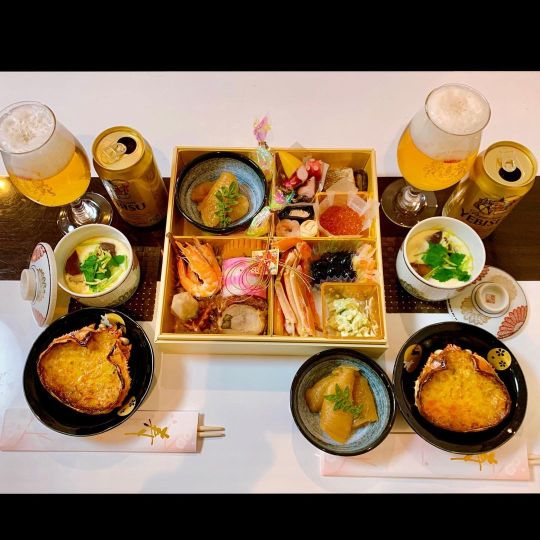
なう(2023/01/03 21:37:07) お節ぜんぶ食べきったー👏 専業主婦でもなーんもせんでえー3日間オワタ🥲 その為のお節料理やもんなぁ、あ!けど今日は 茶碗蒸しだけ作った🙄あ、三賀日でも雑煮だけは 作らなアカンもんなぁけど毎日してる料理の 事を考えたらホンマに楽させて貰いました ありがとう御節料理さまさま…☺️🍱 血圧はかるの怖いから明日にする😌 #正月三賀日おわり #お節料理 #御節料理 #今日の晩ご飯 #家呑み #おうち居酒屋 #おうちごはん #おうちごはん部 #おうちごはんlover #今日の晩ごはん #TodaysDinner #晩ごはん記録 #タベリー #フーディーテーブル #夫婦ごはん #ふたりごはん #豊かな食卓 #cyuley 昨日泊まった宿に出張サービスで来て頂いた 按摩師さん、めちゃくちゃ気持ちよかった😭 40分4千円と町の揉みほぐしに比べたら少し 割高やけど、その辺の揉みほぐしが下手過ぎて 昨日のおっちゃんが神様に思えた😭 2名の出張ができんかったから私の後、旦那が 同じ人にしてもらってたけど旦那も大絶賛🤩 出張や言うても���岡から家までは流石に 来てくれへんねやろなぁ🥺 あの人にまた按摩してもらうにはどないしたら えーんやろ?名刺貰っとけばヨカタ😵💦 とゆうくらい今身体が軽くてスッキリしてる😚 今度摩周に電話して聞いてみよ🤔 https://www.instagram.com/p/Cm9C6nCyp_huNZ9PN9ouUkzqBonFcnZUfypO2U0/?igshid=NGJjMDIxMWI=
#正月三賀日おわり#お節料理#御節料理#今日の晩ご飯#家呑み#おうち居酒屋#おうちごはん#おうちごはん部#おうちごはんlover#今日の晩ごはん#todaysdinner#晩ごはん記録#タベリー#フーディーテーブル#夫婦ごはん#ふたりごはん#豊かな食卓#cyuley
4 notes
·
View notes
Photo

お節料理を買ったのは初めて 夫婦2人だけなら十分すぎるくらいだ とはいえ明日は長男が帰省するから あっという間に消費しそうw #お節料理 #久世福商店 https://www.instagram.com/p/Cm00IFrS8rc/?igshid=NGJjMDIxMWI=
3 notes
·
View notes
Text

⛩️謹賀新年🎍
今年は家族が都合があって帰省して来ないので、楽チンなお正月を過ごしています。お節料理も沢山あっても食べ切れないので(昨夜のすき焼きも余っている)、適当にお皿に盛りました。
今日は天気も良く暖かいので、後で運動がてら、初詣に行ってこようと思います。
1 note
·
View note
Photo

ことしのおせち。初日で完食 #正月 #お節料理 https://www.instagram.com/p/Cm8jNDBPshw/?igshid=NGJjMDIxMWI=
0 notes
Text

小鉢でお節。
106 notes
·
View notes
Photo
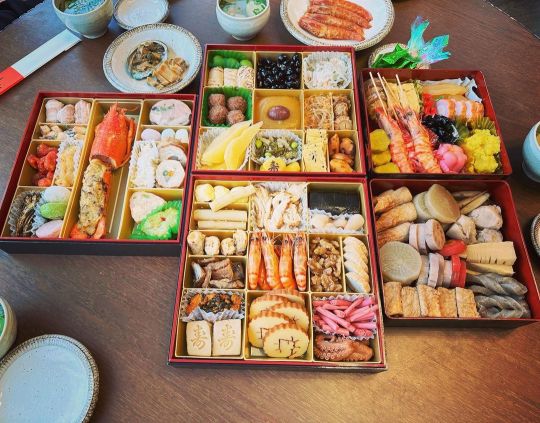
2023年の御節料理はご馳走です。 #2023 #お節料理 #今年の目標 #今年の目標はダイエット #成功する方法 (Maitamonnishi, Tarumi-ku) https://www.instagram.com/p/Cm6puTBSnqj/?igshid=NGJjMDIxMWI=
0 notes
Photo
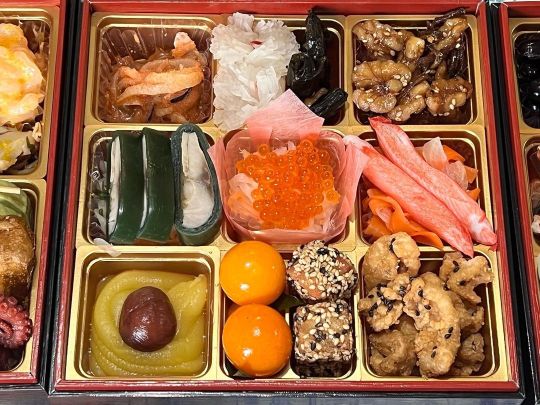
started food life of 2023 😋🍽 #newyearsfood #お節料理 #foodporn #suppersready #thefirstdayof2023 #元日2023 #newyear2023 (at Fukuoka-shi, Fukuoka, Japan) https://www.instagram.com/p/Cm37HYwvOYB/?igshid=NGJjMDIxMWI=
1 note
·
View note
Photo

毎年恒例我が家のお節料理は Restaurant Mitsuyamaさんの 特製イタリアンお節 今年も一晩で食べてしまった ほんまに美味しい 和のお節料理に飽きてる方は是非 今年もご馳走様でした #restaurantmitsuyama #restaurant #mitsuyama #レストランミツヤマ #レストラン #ミツヤマ #イタリアン #italian #お節 #お節料理 #nikon #light_nikon #nikonz9 #nikond850 #z9 #d850 #nikkorzmc50mmf28 #nikkor2470mmf28 (笹尾医院) https://www.instagram.com/p/Cm39pWTSLnc/?igshid=NGJjMDIxMWI=
#restaurantmitsuyama#restaurant#mitsuyama#レストランミツヤマ#レストラン#ミツヤマ#イタリアン#italian#お節#お節料理#nikon#light_nikon#nikonz9#nikond850#z9#d850#nikkorzmc50mmf28#nikkor2470mmf28
0 notes
Text
明けましておめでとうございます
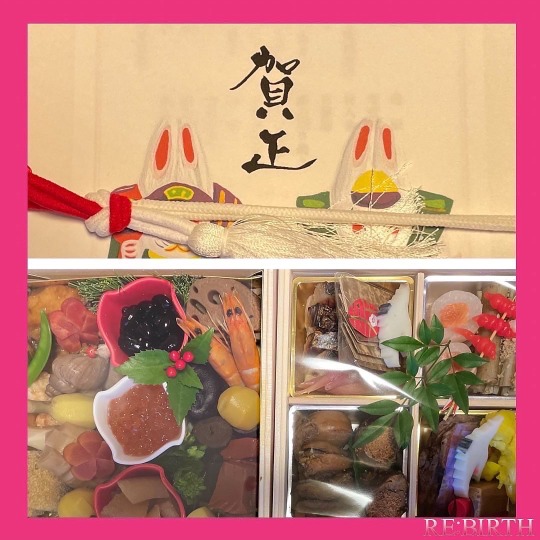

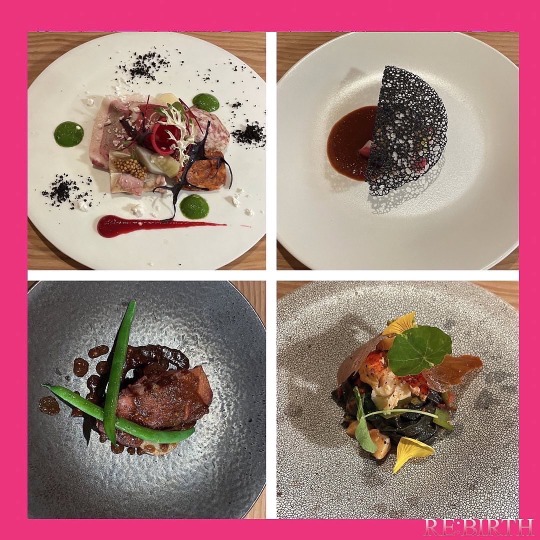
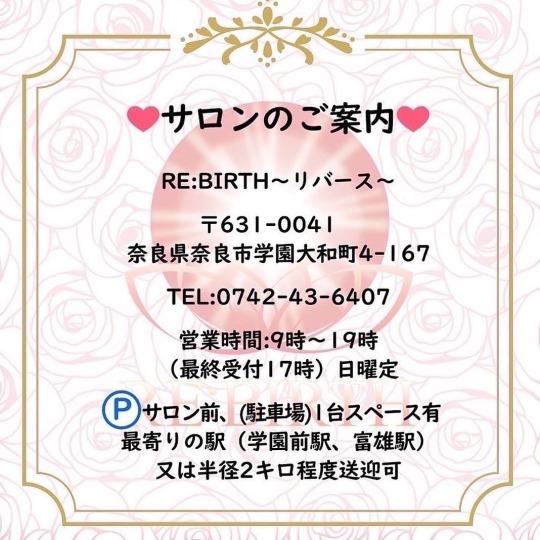

◇明けましておめでとうございます◇
今年も宜しくお願い致します^_^
笑顔いっぱい幸せな良き年となりますように・・・
新年のご挨拶と一緒に^_^
ちょっと季節外れになってしまいましたが、、、
投稿できずだったクリスマスの写真と
今年のおせちの写真を載せますね!
2022年クリスマスディナーとお正月のおせち
クリスマスは主人がサプライズで連れて行ってくれた奈良のイタリアンのお店『コンフォルタ』
おせちは大好きな難波の割烹『料理屋 のだ』
来年90歳になる義母に食べさせたくて、
今年初めて頼んでみました!
https://instagram.com/s.tomoko.rebirth?igshid=YmMyMTA2M2Y=
0 notes

